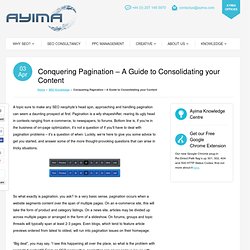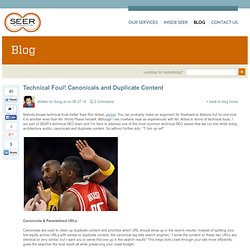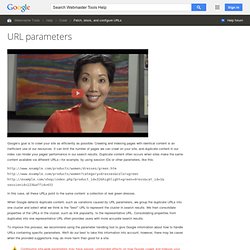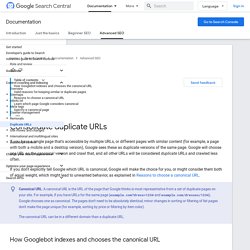

Duplicate Content SEO Advice From Google - Best Practice in 2015. How to Defeat Duplicate Content - Next Level. Welcome to the third installment of Next Level!

In the previous Next Level blog post, we shared a workflow showing you how to take on your competitors using Moz tools. We're continuing the educational series with several new videos all about resolving duplicate content. Pagination for SEO – A Guide to Consolidating your Content. 83inShareinShare83 A topic sure to make any SEO neophyte’s head spin, approaching and handling pagination can seem a daunting prospect at first.

Pagination is a wily shapeshifter, rearing its ugly head in contexts ranging from e-commerce, to newspapers, to forums. Bottom line is, if you’re in the business of on-page optimization, it’s not a question of if you’ll have to deal with pagination problems – it’s a question of when. Luckily, we’re here to give you some advice to get you started, and answer some of the more thought-provoking questions that can arise in tricky situations. So what exactly is pagination, you ask? “Big deal”, you may say. Crawler LimitationsWhen Googlebot is crawling your site, the depth (or levels of clicks deeper into the content) it travels will vary depending on the site’s authority and other factors.
So how do you deal with Pagination? Your best option is always optimal site design. Option 1: Remove your paginated content from the index (Page 1): (Page 2): Page 1: 3 Methods For Managing Pagination According to SEO Best Practices. Technical SEO topics such as pagination are near and dear to my heart. This article will build upon and update my previous treatment of pagination and SEO . I’ve written and presented often on pagination for SEO. Why so much attention on this subject? The reason is simple: it can be a big, hairy deal for sites. Rel=Confused? Answers to Your Rel=Canonical Questions. It’s been over four years (February 2009) since Google and Yahoo announced support for the rel=canonical tag, and yet this single line of HTML is still causing a lot of confusion for SEOs and webmasters.
Recently, Google posted 5 common mistakes with rel=canonical – it’s a good post and a welcome bit of transparency, but it doesn’t address a lot of the questions we see daily here in Q&A. Technical Foul! Canonicals and Duplicate Content. Nobody knows technical fouls better than Ron Artest, period.

You can probably make an argument for Rasheed or Malone but no one took it to another level than Mr. World Peace himself. Although I am nowhere near as experienced with Mr. Artest in terms of technical fouls, I am part of SEER’s technical SEO team and I’m here to address one of the most common technical SEO issues that we run into while doing architecture audits, canonicals and duplicate content.
So without further ado, “T him up ref!” Canonicals & Parametered URLs Canonicals are used to clean up duplicate content and prioritize which URL should show up in the search results. When you see parametered URLs ranking in search results, this is most likely a canonical issue. For instance, here is an example of a parametered URL for a floor rug that is green, made by a specific brand, under $100 and kid friendly.
Check your parameters in GWMT Paginated URLs & Rel=prev/next I cringe whenever I see paginated URLs in search results. URL parameters - Webmaster Tools Help. Google’s goal is to crawl your site as efficiently as possible.

Crawling and indexing pages with identical content is an inefficient use of our resources. It can limit the number of pages we can crawl on your site, and duplicate content in our index can hinder your pages' performance in our search results. Duplicate content often occurs when sites make the same content available via different URLs—for example, by using session IDs or other parameters, like this: In this case, all these URLs point to the same content: a collection of real green dresses.
When Google detects duplicate content, such as variations caused by URL parameters, we group the duplicate URLs into one cluster and select what we think is the "best" URL to represent the cluster in search results. To improve this process, we recommend using the parameter handling tool to give Google information about how to handle URLs containing specific parameters. /store-locator? Use canonical URLs - Webmaster Tools Help.
If you have a single page accessible by multiple URLs, or different pages with similar content (for example, a page with both a mobile and a desktop version), Google sees these as duplicate versions of the same page.

Google will choose one URL as the canonical version and crawl that, and all other URLs will be considered duplicate URLs and crawled less often. If you don't explicitly tell Google which URL is canonical, Google will make the choice for you, or might consider them both of equal weight, which might lead to unwanted behavior, as explained below in Why should I choose a canonical URL? How to Fix the Most Common Advanced SEO Issues – Part 2: URL Parameters.
AUTHOR NOTE – This is part two of a mega-post on what the most common advanced issues are, understanding why advanced SEO issues need more attention than most SEOs give them, and how to fix those issues.

In Part 1 of this series, I gave a basic overview of how my cumulative site auditing experience has helped me realize that even though every site is unique and thus has unique problems, most sites—from small mom & pop eCommerce sites all the way up to global reach sites with more than 100,000,000 pages—share a number of advanced SEO problems. Today, I want to start showing what to look for, how to determine the severity of problems, and how to go about the work of resolving them, starting with URL parameters.